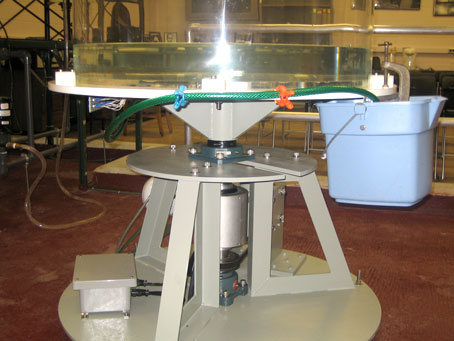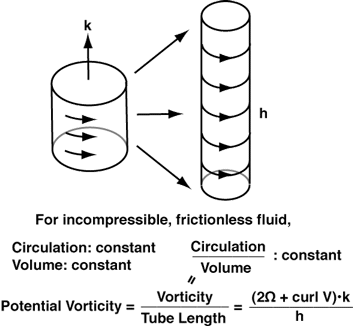
To drain from the rotating tank, the bucket is attached to the turntable.
Sink vortex and Hurricane Katrina
Have you heard someone say that when you drain a bathtub in the Northern Hemisphere, water swirls down the sink counterclockwise because of the earth's rotation?
Don't believe it. If the water swirls as it drains through the sink, it is probably due more to the particular design of the sink than anything else. The planet's rotation has very little effect on the draining water, unless the water is drained extremely slowly. Only if the drainage takes a day or longer does the planet's rotation become detectable (viz. the Rossby number becomes small enough).
Seeing is believing. In the movie below, the motion of water around the sink is visualized by tea leaves. When water is drained, tea leaves at the bottom are slowly sucked into the sink. When the water level becomes sufficiently low, the entire column of the water quickly converges. The flow is slightly asymmetric because of the proximity to the wall, but there is no formation of a prominent vortex. A boring experiment...
When the tank is rotating, the situation is drastically different. In the next experiment, we will rotate the tank counterclockwise at 10 rpm. At this rate, the time scale of rotation is comparable to the time scale of the flow. Since the camera is rotating with the tank, the tank appears stationary but the floor is moving clockwise. As soon as the water starts to be drained, a counterclockwise vortex emerges over the sink. After the drain valve is shut, the vortex is detached from the sink and starts to migrate toward the lower right.
 To drain from the rotating tank, the bucket is attached to the turntable. |
The spinup of the vortex is due to the stretching of water column that is rotating with the apparatus. The principle is analogous to the conservation of angular momentum, and it works as follows. For an incompressible, frictionless fluid, velocity integrated around a material circuit, called circulation, is a constant of motion. Circulation is what would be angular momentum for a rigid body, but here the shape of the circuit can change with time. Also, mass (volume) of a material tube is conserved follwing the fluid motion. Thus, the ratio of these two numbers is also a constant of motion. In the limit of vanishing volume, this ratio approaches vorticity divided by the length of the tube (show this!).
 |
As the column of water is drained at the sink, it is stretched downward, so the tube length h increases. To keep potential vorticity constant, vorticity needs to increase, so when Ω > 0, positive (cyclonic) relative vorticity is spun up. However, if the fluid is nonrotating and its vorticity is zero to begin with, then stretching does not create any relative vorticity, because potential vorticity remains zero whether the tube is stretched or not. In other words, the sink vortex feeds itself off of the preexisting vorticity associated with the rotation of the tank.
The same mechanim is at work in the growth and maintenace of a hurricane. (The differences between water and air turn out to be inconsequential here.) The animated satellite image below of the catastrophic Hurricane Katrina that hit the Gulf states in 2005 exhibits a striking resemblance to the sink vortex.
For a hurricane, release of latent heat of condensation during cloud formation causes intense buoyancy in the eye wall, which provides the vertical stretching of the tube. Hurricanes still need preexisting vorticity to start spinning: that's why they do not form over the equator, where the effective rotation of the planet (i.e., the rotation vector projected on the local vertical axis = 2Ω • k) vanishes. In the Northern Hemisphere, the rotation of the planet is counterclockwise so the hurricanes also spin counterclockwise, as in the sink experiment above. Upon landfall, the supply of water vapor to the hurricane is cut off, so its intensity diminishes rapidly due to surface friction. This is similar to the the vortex in the above experiment that is cut off from the sink after the drain valve is shut.
In the experiment above, if the rotation of the turntable is reversed, the sign of the vorticity is also reversed. In the movie below, the turntable is rotating clockwise 7 times per minute. The vortex that appears over the sink spins clockwise this time. Similarly, hurricanes in the Southern Hemisphere spin clockwise.